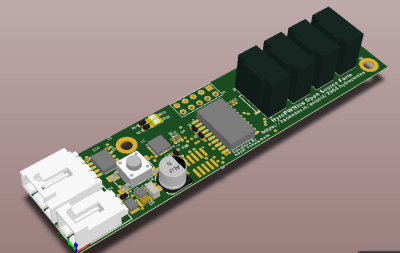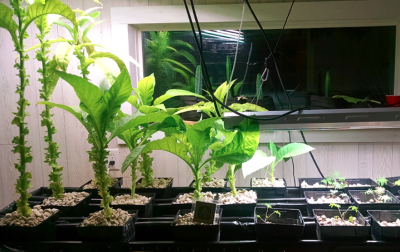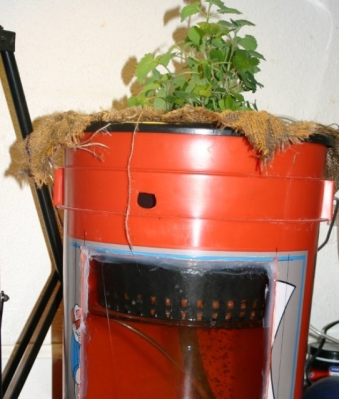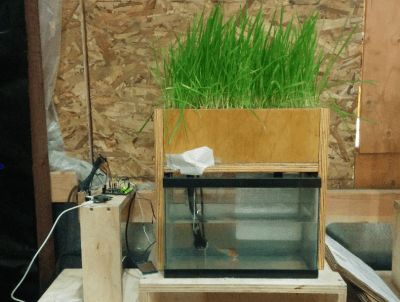Growing plants without soil has been has been amazing people for centuries. First written about in the 1600’s, hydroponics has become an industry with numerous techniques for germinating and sustaining both plant and animal life. It comes as no surprise then that hackers, makers, engineers, and scientists have been working with and improving hydroponic systems for centuries. Hydroponic plant growth is a project you can really sink your teeth into, as there’s nothing sweeter than eating the fruits and vegetables of your labor. This week’s Hacklet is all about the best hydroponic projects on Hackaday.io!
 We start with HydroPWNics, [Adam Vadala-Roth’s] entry in The 2015 Hackaday Prize. [Adam] is creating a universal system with will work with both hydroponic and soil based grow systems. The hydroponic setup will consist of plants in a PVC gutter system. Water will be pumped to the top gutter, and flow down via gravity through the plant roots and back to the reservoir. The system will be monitored and controlled by a DyIO controller. Props to [mad.hephaestus] for creating DyIO, a project seeing reuse in the Hackaday.io community!
We start with HydroPWNics, [Adam Vadala-Roth’s] entry in The 2015 Hackaday Prize. [Adam] is creating a universal system with will work with both hydroponic and soil based grow systems. The hydroponic setup will consist of plants in a PVC gutter system. Water will be pumped to the top gutter, and flow down via gravity through the plant roots and back to the reservoir. The system will be monitored and controlled by a DyIO controller. Props to [mad.hephaestus] for creating DyIO, a project seeing reuse in the Hackaday.io community!
 Next up is [Justin] with AAGriculture, an Automated Aquaponic Garden. AAGriculture is aquaponic system, which means it uses a symbiotic relationship between plants and fish to make more food for humans to eat. The fish in this case are bluegill and bullhead. A Raspberry Pi controls the system, while A Teensy-LC is used to help out with some of the real-time duties, like monitoring a PH probe. [Justin] is even using CO2 tanks to keep dissolved gasses in check. He must be doing something right, as his tomatoes are now over 23″ tall!
Next up is [Justin] with AAGriculture, an Automated Aquaponic Garden. AAGriculture is aquaponic system, which means it uses a symbiotic relationship between plants and fish to make more food for humans to eat. The fish in this case are bluegill and bullhead. A Raspberry Pi controls the system, while A Teensy-LC is used to help out with some of the real-time duties, like monitoring a PH probe. [Justin] is even using CO2 tanks to keep dissolved gasses in check. He must be doing something right, as his tomatoes are now over 23″ tall!
 [Em] brings us 5g Aquaponics. 5g aquaponics isn’t a next generation cellular system, nor a 5.8 GHz WiFi setup, it’s an aquaponic system in a 5 Gallon bucket. Anyone from the US will recognize the orange “Homer Bucket” from Home Depot. 5g Aquaponics includes a window, allowing the underwater workings to be monitored. Speaking of monitoring, 5g aquaponics is a manual affair – [Em] hasn’t used any electronics here. The idea is to create a system that is easy to get up and running for those who are new to Hydro/Aquaponic setups. [Em] is using a dual zone root system. The plant grows in dirt within a burlap fabric. The fabric then sits in a water bath which also houses the fish. Air pumped through an airstone keeps everything circulating. [Em’s] initial version of the project worked a bit too well. The tomato plant grew so large that the roots strangled the fish! Hopefully both flora and fauna are happy with this new rev 2.0!
[Em] brings us 5g Aquaponics. 5g aquaponics isn’t a next generation cellular system, nor a 5.8 GHz WiFi setup, it’s an aquaponic system in a 5 Gallon bucket. Anyone from the US will recognize the orange “Homer Bucket” from Home Depot. 5g Aquaponics includes a window, allowing the underwater workings to be monitored. Speaking of monitoring, 5g aquaponics is a manual affair – [Em] hasn’t used any electronics here. The idea is to create a system that is easy to get up and running for those who are new to Hydro/Aquaponic setups. [Em] is using a dual zone root system. The plant grows in dirt within a burlap fabric. The fabric then sits in a water bath which also houses the fish. Air pumped through an airstone keeps everything circulating. [Em’s] initial version of the project worked a bit too well. The tomato plant grew so large that the roots strangled the fish! Hopefully both flora and fauna are happy with this new rev 2.0!
 Finally we have [Kijani grows] with Smart Aquaponics, which was [Kijani’s] entry in The 2014 Hackaday Prize. One wouldn’t expect fish, plants and Linux to mix, but that is exactly what is going on here. Linux runs on the popular Wr703n router, while a custom ATmega328 Arduino compatible board keeps track of the sensors. The second version of the system will run on an ATmega2560 and an AR9331 module, all housed on one board. The system does work, and it’s been expanded from a single fish tank to a large flood/drain table complete with grow lights, all kept at [Kijani’s] office. The biggest problems [Kijani] has run into are little things like misplaced resistors masquerading as kernel bugs.
Finally we have [Kijani grows] with Smart Aquaponics, which was [Kijani’s] entry in The 2014 Hackaday Prize. One wouldn’t expect fish, plants and Linux to mix, but that is exactly what is going on here. Linux runs on the popular Wr703n router, while a custom ATmega328 Arduino compatible board keeps track of the sensors. The second version of the system will run on an ATmega2560 and an AR9331 module, all housed on one board. The system does work, and it’s been expanded from a single fish tank to a large flood/drain table complete with grow lights, all kept at [Kijani’s] office. The biggest problems [Kijani] has run into are little things like misplaced resistors masquerading as kernel bugs.
Still haven’t eaten your veggies? Want to see more hydroponic projects? Check out our new hydroponic projects list! That’s it for this week’s Hacklet, As always, see you next week. Same hack time, same hack channel, bringing you the best of Hackaday.io!
















Use the sun and you will grow food with less energy…Heat the root system and you will increase yield…
https://hackaday.io/project/5999-the-smart-garden-mini
The power consumption is not excessive until the Feds start flying over your house at night helicopters. Seriously though, you have to consider things like the price of produce in the winter time, and losing half your garden to pests, and you don’t even need that much energy if you have a nice big window.
If you ever do get a pest or disease the dense monoculture ensures an almost total loss. At least for the hobbyist who might not notice it before it’s spread.
You can reduce this risk easily if you use a protocol for introducing new plants though.
Electricity isn’t a big issue either with LED and CFLs that mimic the appropriate spectrum. Further choosing plants that aren’t picky about it (eg; peppers & greens) cheapens the investment. Again, specific spectra of light aren’t expensive to get anymore, though local availability may guide purchases.
I guess I am a little confused. My math on the electricity utilization for an indoor tomato plant is as follows:
Grow Light Wattage = 100W (Based on this website: https://www.hydroponics.net/items/details/choose_a_grow_light.asp) – scaled down 100W to be conservative.
Cost of Electricity per hour = $0.378 (based on $3.78/kW hour, which includes all the taxes and surcharges in my electricity bill)
Hours of light per day = 10
Hours of light per month = 10*30=300
Hours of light per 6 month growing season = 300*6=1800
Total cost of electricity to light tomato plant = 1800*$0.378 = $374.98
$375 seems like a lot of money to spend on electricity? If we price tomatoes at $4/pound, wouldn’t we need to grow almost 94 pounds of tomatoes just to break even on the electricity cost?
That’s using HPS and MH bulbs. Using watts is a bad way to estimate lighting needs. Lumens are better, but still not entirely accurate, ideally one should use mols of photons, but that’s a bit involved and for hobbyists lumens or watts may suffice.
CFLs and LEDs are available in watt equivalent. A daylight spectrum 1100 lumen bulb will draw a bit over 20 watts of electricity, A similarly sized LED draws a bit less than 20 watts, but for simplicity we’ll call them both 20 watts. Still $75 for 2-3 plants is a bit much.
You’ve sure got a raw deal on electricity. Pulling from off-peak times may change your taxes. Finding a decent window will also help by cutting out hours, even if only for half of the bulbs. If one were doing this commercially rooftop gardens & PV arrays would be a worthwhile investment.
You sure about that? We pay $0.21/kW hour, not including tax or line charges. In NZ but still….
Where are you that electricity is $3.78/kWh? That’s an order of magnitude higher than is typically seen. With that price your solar payback would be <1yr.
Yea Looks like I really screwed up the numbers on this one. Price per kW hour is ~$0.16 in my area.
Would like to see this guy covered on this subject as he sems to be showing the way in so many ways. https://rik94566.wordpress.com/
g is gram G is gallon.
Using 3 wooden gutters rather than 1-2 large trays seems expensive. It also cuts down on grow area. It does give you more freedom with plant choice/nutrient requirements but only if you’re pulling from separate reservoirs.
@Frank
A lot of these are built by people with short growing seasons, or poor soil. Yes it’s better to amend the soil in the long run but it’s not always convenient short term. Also you can get better plant density on a commercial scale if you can grow indoors since you can grow vertically.
I heard vertical farms didn’t do that well in the market.
How hard did you have to look to find hydroponics projects that weren’t growing pot? :-)
Not very hard probably.
Trick question. They are all actually growing pot.
HAHAHAHAHAHAHAHAHAHAHA
Biopower Usb charger